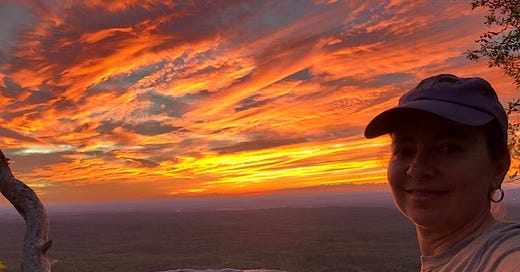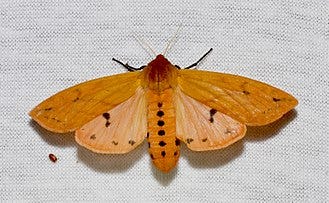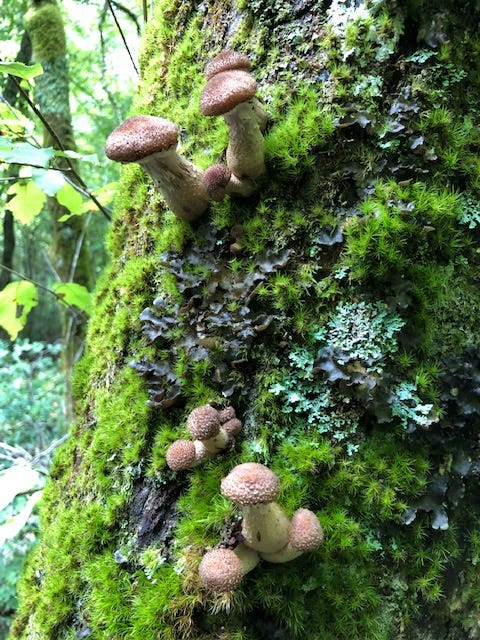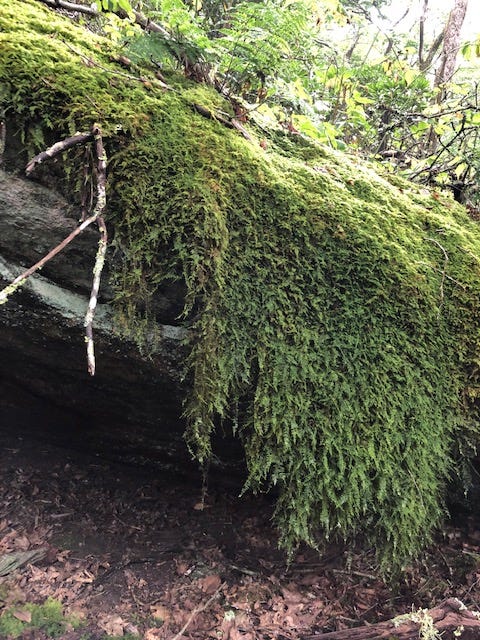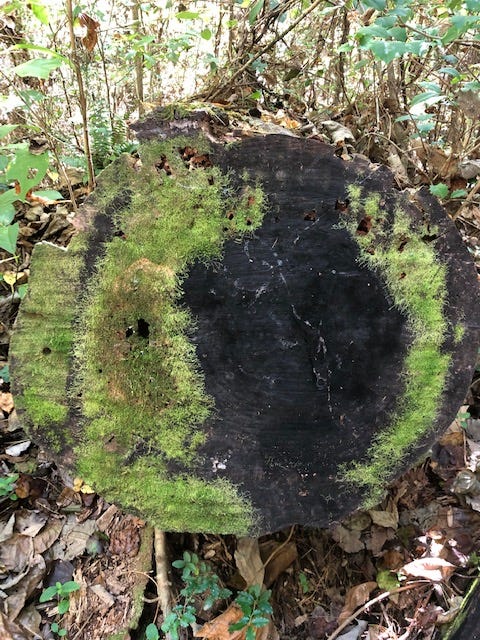When can I believe Nature folklore?
Welcome to Natural Wonders, where I hope to pique your interest each week by sharing some fascinating questions and answers about natural phenomena. If you’re new here or if someone forwarded you this email, you can subscribe below.
Check out past posts by going here and see who I am and what Natural Wonders is about here.
How often have you heard a saying from old-timers that promises, “You’ll know it’s going to be a hard winter if a wooly worm has lots of black fur” or “You can’t get lost in the woods because moss always grows on the north side of trees”? During a trip to Cheaha State Park a while back, I took the above photo during a sunset. It makes me think of the old saying, “Red skies at night, sailors delight.” According to the adage, we should have had great weather the next day. But I remember thinking the sunset was so fantastic because a huge hurricane was coming in from the gulf – wouldn’t that mean we were about to get hammered with rain?
So, I started wondering…
When can I believe Nature folklore?
I’ve started collecting folklore sayings about nature and found there are quite a few about weather – perhaps because predicting storms and hard frosts is important if you’re a farmer or you’re out enjoying the outdoors. But I also remember during my childhood hearing quite a few about how to survive in the wilderness, which was likely because I was surrounded by so very much of it. For this newsletter I decided to check out several different sayings, the first being:
Can I trust red skies at night?
The complete quote is:
Red skies at night, sailors delight; red skies in morning, sailors take warning
This saying is extremely old, even going back to the Bible: (Matthew XVI: 2-3) Jesus said, “When in evening, ye say, it will be fair weather: For the sky is red. And in the morning, it will be foul weather today; for the sky is red and lowering.”
It turns out that this saying is, for the most part, true. When we see red skies during a sunset, it’s because there is dust or moisture in the air causing the sun’s light to refract; it’s mostly the red wavelengths (the longest ones) that make it through the atmosphere.
Since weather systems travel from west to east in the middle latitudes, when we see red light peering through the clouds in the west, that means the clouds are breaking up and fairer weather is on the way – if a big weather system were headed our way, the clouds would be so thick that direct sunlight wouldn’t penetrate them at sunset. The fact that I could see the red wavelengths of sunlight in the photo above meant the clouds were breaking up and would have passed over by morning.
On the other hand, if sailors see a red sky in the morning, that means the rising sun is shining through clouds with moisture in the east. Wouldn’t that mean the bad weather has already passed the sailor, since weather tends to move from west to east? It turns out red skies at morning is a warning if the rising sunlight is bouncing off of approaching clouds in the west, rather than peeking through a cloudbank in the east. The saying doesn’t work on those occasions when weather systems move in different directions – from south to north, say, or with a nor’easter that blows winds from the northeast.
Verdict: this saying is mostly true.
Can wooly worm really tell how hard the winter will be?
The lore says that the amount of black on the wooly worm (or “wooly bear”) indicates the severity of the winter. The larger the middle brown section, the milder the winter will be. Some say the length of the black patches corresponds to which part of winter will be harder – for instance, if the head of the wooly worm is longer and darker, that means the beginning of winter will be severe. The wooly bear’s body also has 13 segments, which supposedly correspond to 13 weeks of winter.
There is actually no connection between the wooly worm’s coloring and the upcoming winter. Wooly worms are caterpillars that turn into Isabella Tiger moths. They molt six times before they build their cocoon to transform into a moth and each time they molt, their “fur” turns less black and more reddish. There are 260 species of tiger moths, each with slightly different coloring. So, the difference in the colors of wooly worms from year to year might indicate their molting stage or it might be a result of seeing different species.
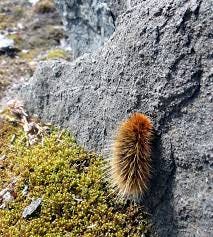
Here’s something that’s really cool about wooly worms: most regular caterpillars live between 2-4 weeks before building their cocoon. The wooly worm is different, however; it remains a caterpillar over the winter, slowly freezing into a state of suspended animation at temperatures as low as -90 degrees. It does this by producing antifreeze that prevents it from freezing entirely. And get this — artic wooly worms (like in the picture above) live up to 14 years as caterpillars, refreezing each winter, before finally turning into a moth for only 24 hours. It’s during this one-day period that they lay eggs before dying.
Verdict: Wooly worms can’t be trusted with weather prediction, but they’re still kind of amazing.
If I see salamanders in a creek, does that mean it’s clean to drink?
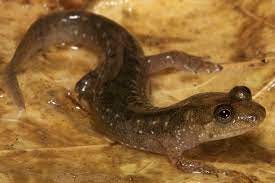
I heard this old saying growing up in the Appalachian Mountains. I’d also heard that it’s ok to drink water bubbling directly out of a spring. A friend of mine was told by an old-timer If water runs over 7 rocks, it’s good to drink. But are any of these true?
First of all, the best way to make sure you don’t get giardia or some other pestilence is to make sure to bring enough water with you when you’re out in the woods. If you’ll be out for a while, bring iodine drops or a mechanical water filter like a Life Straw.
But sometimes life happens and you run out of water. In that case, it’s best to collect from running water since standing water collects bacteria. Water is generally cleaner the closer you get to its source because there’s less likelihood of nasty runoff from animal/human waste. Getting water directly from a spring is preferable since it does get filtered as it runs underground through rocks, sand, and dirt; however, that won’t purify possible chemicals from underground contamination, such as buried trash.
Salamanders, it turns out, really are a good indicator of clean water. Lungless salamanders, like the black-bellied salamander of the Appalachians, breath through their skin and are therefore extremely sensitive to environmental changes due to pollutants or contamination. If they encounter toxins they typically move to a different, cleaner water source. Because of this, they’re considered an “indicator species” for their ecosystems.
Verdict: trust the salamanders!
Does moss really grow only on the northern side of trees?
Supposedly, if you’re lost in the forest, you should be able to navigate your way out by closely examining the moss on trees to find north. I was pretty skeptical of this one since I’ve taken lots of pictures of moss and it seems like it’s everywhere, covering logs, rocks, and all sides of trees.
It turns out that moss doesn’t only grow on the north side of trees – it grows just about everywhere that’s moist enough for it to survive. However, it IS more likely that you’ll find more moss on the northern side of trees simply because, as the sun travels from east to west, the northern side of trees (and rocks and stumps) is shadier and slightly cooler. Using that logic, can you guess on which side of a tree you’d likely find moss in the southern hemisphere? Yep, moss tends to collect on the shady southern side of trees below the equator.
Verdict: bring a compass – the differing amounts of moss on north-facing surfaces is too subtle.
What nature sayings have you heard before? Are you skeptical or do you believe them? Share them in the comments - we have newsletter subscribers from all over the U.S. and the world (including the Southern Hemisphere!), so share what you’ve heard and let’s compare notes!
Nature Break: A friend of mine shared this idea from an elderly AT thru-hiker he knows: walk the same path or trail multiple times a year. Pick 10 places along the trail to study – really stop, and look for what has changed since the last time you were there. What has happened in your absence? What’s new? What is gone since your last visit? How is today’s weather affecting each spot?
Weird Nature

Detritus
Fish may not have vocal cords, but they can make a wide variety of sounds and now there’s a database that’s collected them.
I’m a sucker for award-winning photo collections, so I was excited to come across the 2021 winners of the World Nature Photography Awards.
I’ve written before about why beech trees keep their leaves all winter. I’ve recently noticed that while many trees are starting to put out their baby leaves and flowers, our beech trees are still determinedly hanging onto their leaves. When will they finally let go and let their tiny leaf buds unfurl? It turns out beech trees won’t “wake up” until there’s 12-14 hours of sunlight each day. They’re like the Grandpa Simpsons of the tree world.
If you’re enjoying this newsletter, please take a moment and share it with two of your friends you think would enjoy it too - just click the Share button below to copy the link.

